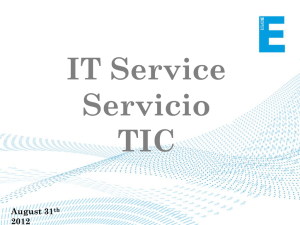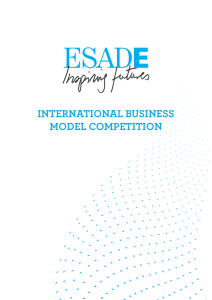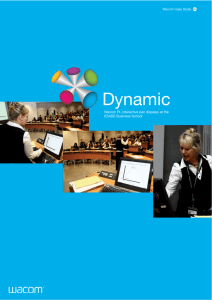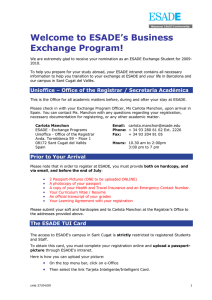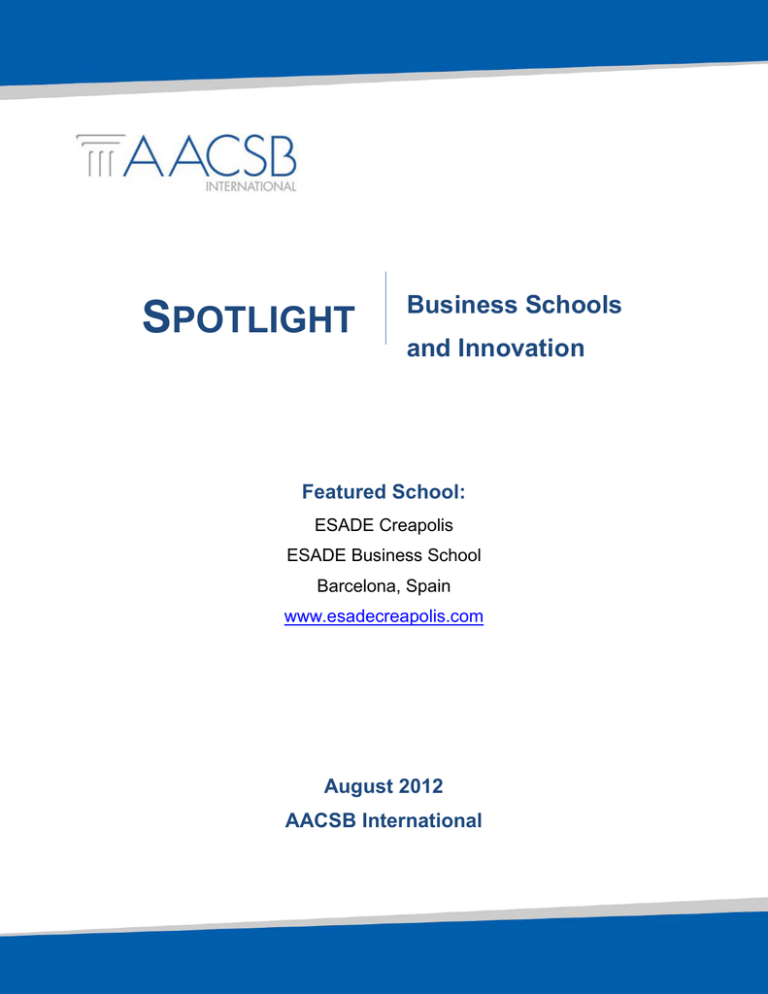
SPOTLIGHT
Business Schools
and Innovation
Featured School:
ESADE Creapolis
ESADE Business School
Barcelona, Spain
www.esadecreapolis.com
August 2012
AACSB International
SPOTLIGHT | Business Schools & Innovation
ESADE Business School | 2
ESADE Creapolis
In 2005, Barcelona’s ESADE Business School founded ESADE Creapolis – the first international
1
business innovation park to practice “Open Innovation.” In building and designing Creapolis, meticulous
attention was given to creating a park whose design, structure, and available amenities would come
together to create the ideal environment for fostering innovation among its residents. As Dean Alfons
Sauquet explains, an “element of circumstance and opportunity to meet faculty interests and the school’s
strategic plan” was behind the implementation of Creapolis. From the start, ESADE faculty,
administration, and the Director-General at the time strongly advocated for the initiative, which would
follow the school’s strategic mission of supporting innovation in business.
Mission of Creapolis
The mission of Creapolis is to “speed up innovation by providing space (both physical and knowledge) to
stimulate interaction between the business school, the business world, and other knowledge and
innovation networks in order to detect new market opportunities, and drive their successful development
2
and marketing.” Innovation is viewed as an attitude rather than a set of processes, adds Sauquet.
Creapolis does not follow the typical technological value-added process, nor can it be characterized as
being an incubator. According to ESADE, Open & Cross Innovation is “a collaborative work, exchanging
3
knowledge and experience across sectors in order to accelerate innovation.” Sauquet emphasizes that
the park’s main focus lies on this concept and centers on the activities taking place outside organizational
bounds, bringing them inside the organization, and analyzing how they can be useful to the organization.
By encouraging optimal representation from various sectors, the philosophy behind Creapolis is that it will
enhance the lateral innovation processes of a company through the guidance of ESADE experts and the
collaboration and cohabitation between participants. Creapolis firmly supports the belief that “No
organization should believe that the best ideas and most successful products/services that they are going
to bring to market are produced alone and solely from within their own organization. A company will have
to work and collaborate with the best, whether they are inside or outside of the organization.”
4
Becoming Involved
Companies apply to become residents at Creapolis, and upon acceptance pay a fee to “rent” a space in
the park. Companies can choose to rent an iOffice or Business Center Commercial Space Suite. While
the iOffices are larger and more customized spaces, both include access to common areas designed to
encourage “Open & Cross Innovation.” Such areas include:
© AACSB International. All Rights Reserved.
SPOTLIGHT | Business Schools & Innovation
•
Coffee Brain Corners
•
Open & Cross Innovation Labs
•
Focus Group Rooms
•
Meeting Rooms
•
Open Offices
•
Perimeter Terraces
•
Green Areas
ESADE Business School | 3
5
Included in the rent are services such as training programs and seminars on aspects of business creation
and entrepreneurship, as well as “care and first diagnosis of new projects” (start up, spin off,
6
entrepreneurship). Residents pay to “live” in the Creapolis ecosystem and participate in various events
and meetings at the business park, where they are presented with opportunities to interact with ESADE
faculty and academics and other residents. Residents also have access to an international network of
entrepreneurs and business schools through ESADE Business School, as well as through the Innovation
7
Club of ESADE Alumni. The flat rate for residency is currently under discussion, with either moving to a
sliding scale based on levels of access and participation, or establishing a differential cost based on the
company’s stage of development, being considered as resident rent options. Sauquet adds that
companies remain with the park on average two to four years; however some of the original residents are
still at Creapolis. The resident fees in combination with other funds from ESADE are used to subsidize the
park.
The application process for residents is run by the management team of the business park, which is
comprised of non-faculty members serving various functions at Creapolis. The management team is
guided by the Board of Creapolis and oversees the effectiveness of arrangements and makes changes
where necessary. The Board comprises the Program Director of Creapolis along with faculty who are
involved with innovation activities at ESADE. The Board members meet bi-monthly to discuss the
activities and outputs at the park, as well as search for areas in and outside ESADE that Creapolis can be
involved in. ESADE faculty play an important role at Creapolis, and the business school maintains a proactive role in encouraging faculty to share their innovation interests, become involved with projects and
related research, and act as a resource for the park’s staff and residents. For instance, residents can
enquire about access to information and documentation about innovation and resources from the ESADE
Business School library, or have their company be the subject of a case study prepared by ESADE
Business School and its partner universities.
© AACSB International. All Rights Reserved.
8
SPOTLIGHT | Business Schools & Innovation
ESADE Business School | 4
The Ecosystem
The sharing of formal and informal environments through coexistence with other residents, as well as
faculty and other experts, is central to the Creapolis’s mission to promote effective collaboration, and as a
result, lateral innovation among these groups. Sauquet shares an anecdote in which a designer asked
where the coffee machines would be located in a facility he was building, considering that these locations
would inevitably be where the most interaction among staff would take place, and would require special
attention in designing and constructing. Intentionally designing and including these types of ‘hot spots’ for
resident interaction is one of the main aspects and goals behind the design of Creapolis.
The amenities and facilities within the business park are strategically designed with the motto,
“Accelerate your innovation, take advantage of opportunities, orientate your business to the market,
9
increase your profitability,” in mind. The business park’s design and construction was led by two teams
of individuals. One team focused on the academic needs, while the other strived to create an
infrastructure with multi-functional spaces that would also encourage frequent interaction among
residents. The aim is to foster a “loose” atmosphere allowing easy access to the park’s amenities and coresidents. Each detail of the design was heavily discussed and analyzed among the teams. For example,
initially the park was envisioned to be a completely open space with no walls, but the idea was dismissed
after much debate. Sauquet explains that the park’s infrastructure is still a work in progress and is
continuously open to modifications and new innovations in order to fit the needs of its residents.
Looking Ahead
Creapolis was born as a relatively local initiative, however throughout the years has gained more
international interest and is attracting more international residents – currently over 40 countries are
represented by the resident companies. At ESADE 85 percent of programs are delivered in English, and
Sauquet adds that there are plans to expand the business school’s activities and programs to Creapolis.
Although internship opportunities at Creapolis are available to MBA students, Sauquet and staff aim to
enhance this practice by making more linked connections between Creapolis and the MBA program. MBA
students have expressed enthusiasm for more hands-on opportunities for their own entrepreneurial
ambitions with the various innovation activities taking place at Creapolis, says Sauquet. So far,
companies who reside in the park have shown to be less eager in working more directly with students, but
Sauquet believes the value in such collaboration will inevitably be realized. For instance, the CEO of
Peugeot wanted to look into the use of electrical cars, and utilized students from the business school as
well as those from technology fields to aid in the research and exploration of this issue, finding the
experience to be a valuable one.
© AACSB International. All Rights Reserved.
SPOTLIGHT | Business Schools & Innovation
ESADE Business School | 5
Much of the success that residents of Creapolis gain from their involvement with the park comes from
their own commitment to being open in exchanging and sharing ideas with other residents. The
philosophy behind Creapolis, as well as the support of Creapolis staff and ESADE faculty and
administration helps create an open environment in which residents feel comfortable reaching out to their
neighbors to share and discuss plans, ideas, and problems that their companies might be facing. Sauquet
praises the Creapolis’s strong commitment to the practice of Open Innovation, which “allows residents to
find solutions two doors down,” to be the main driver for the success and the unique-factor of the park.
Acknowledgements: AACSB International is grateful for the assistance of Alfons Sauquet Rovira, Dean of
ESADE Business School.
© AACSB International. All Rights Reserved.
SPOTLIGHT | Business Schools & Innovation
ESADE Business School | 6
End Notes
1
ESADE Creapolis (2012). About Us webpage. Electronic Document,
http://www.esadecreapolis.com/index.php?option=com_content&view=article&id=79&Itemid=123&lang=en,
accessed on May 15, 2012.
2
ESADE Creapolis (2012). About Us webpage. Electronic Document,
http://www.esadecreapolis.com/index.php?option=com_content&view=article&id=79&Itemid=123&lang=en,
accessed on May 15, 2012.
3
ESADE Creapolis (2012). Open Innovation webpage. Electronic Document,
http://www.esadecreapolis.com/index.php?option=com_content&view=article&id=43&Itemid=106&lang=en,
accessed on May 15, 2012.
4
ESADE Creapolis (2012). Open Innovation webpage. Electronic Document,
http://www.esadecreapolis.com/index.php?option=com_content&view=article&id=43&Itemid=106&lang=en,
accessed on May 15, 2012.
5
ESADE Creapolis (2012). iOffices webpage. Electronic Document,
http://www.esadecreapolis.com/index.php?option=com_content&view=article&id=101&Itemid=213&lang=en,
accessed on May 15, 2012.
6
ESADE Creapolis (2012), Start-Up Assistance webpage. Electronic Document,
http://www.esadecreapolis.com/index.php?option=com_content&view=article&id=96&Itemid=206&lang=en.
accessed on May 29, 2012.
7
ESADE Creapolis (2012), Information, Networking and Communication webpage. Electronic Document,
http://www.esadecreapolis.com/index.php?option=com_content&view=article&id=97&Itemid=240&lang=en,
accessed on May 29, 2012.
8
ESADE Creapolis (2012), ESADE Business School webpage. Electronic Document,
http://www.esadecreapolis.com/index.php?option=com_content&view=article&id=98&Itemid=208&lang=en,
accessed on May 29, 2012.
9
ESADE Creapolis (2012), Accelerate Your Innovation webpage. Electronic Document,
http://www.esadecreapolis.com/index.php?option=com_content&view=article&id=39&Itemid=199&lang=en,
accessed on May 15, 2012.
© AACSB International. All Rights Reserved.

